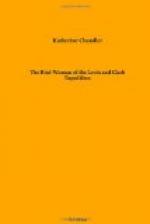We do not eat them.
What poor men these must be to eat dog!”
Suddenly the captains fired off their guns and a soldier played the
fiddle.
Then the Indians stopped laughing.
They had never heard a gun before.
They had never before heard a fiddle.
They thought the white men must be wonderful people to have guns and
fiddles.
They wished to be friends with such wonderful people.
So they did not make fun of them any more.
full grass stones
HOW THE INDIANS DRIED SALMON.
The soldiers left their horses here on the Columbia
River.
They asked the Indians to keep them until they should
come back from the
West.
Then they started down the river in canoes.
On the Columbia, the party saw some Indians drying
salmon.
They opened the fish.
Then they put it in the sun.
When it was well dried, they pounded it to powder
between two stones.
Then they put it into a basket.
The basket was made of grass.
It had dried salmon skin inside.
The Indians pounded the powdered salmon down hard
into the basket.
When a basket was full, they put dried salmon skin
on the top.
Then the basket was put where it would keep dry.
The salmon powder would keep for years.
Only one tribe of Indians knew how to make it well.
The other tribes bought it from them.
All the tribes liked it.
The white men, too, liked it.
gath ered ar row head
sum mer wap pa to
pond toes
THE WAPPATO.
The party found a root new to them on the lower Columbia.
The Indians called it wappato.
Captain Clark called it arrowhead.
The wappato grew all the year.
The Indian women gathered it.
A woman carried a light canoe to a pond.
She waded into the pond.
She put the canoe on the water.
With her toes she pulled up the wappato from the bottom
of the pond.
The woman caught it and put it in the canoe.
She was in the water many hours, summer and winter.
When her canoe was full, she put it on her head and
carried it home.
She roasted the wappato on hot stones.
It tasted very good.
The soldiers said it was the best root they had tasted.
The Indian women used to put some wappato in grass
baskets and sell it
to the tribes up the river.
anx ious cheer ful view break ing dis tinct ly shores




